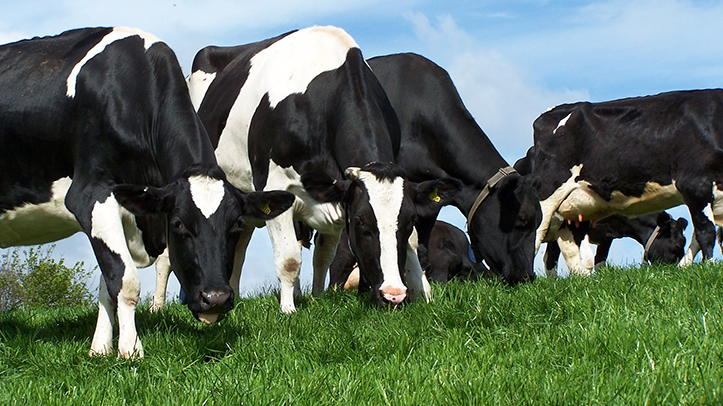With this spring being one of the wettest on record, with many herds significantly delayed getting out of the sheds, it is now important to keep cows on track, advises nutritional supplement manufacturer UFAC-UK.
“Normally at this time of year we would be looking at butterfats following turnout, but we are also facing the challenge of a lack of energy,” explained Mark Townsend, UFAC-UK’s ruminant technical manager.
Early grazing data highlights that energy is limited for grazing animals, with Milk Yield from Grazing (MYFG) values continuing to fall, which could be problematic for spring calving herds turning fresh cows out.
With early grass having a very low dry matter content this year, and energy levels lower than usual, dry matter intakes will also be limited.
Supporting nutrition at grass will therefore be key to maintaining yields and butterfat production, in turn helping to support margins. However, it is important to also focus on the overall energy density of the diet.
Maximise DMIs and margins
“The efficient use of grass by precision feeding can help increase milk from forage, but it is vital that grazing is measured and managed. It can then be balanced with the correct buffer feeding, to maximise DMIs and margins,” advised Mr Townsend.
“To maximise forage DMIs, we first need to know what we are feeding, so we should regularly analyse all forages, and balance them with the correct nutrients, such as structural fibre, sugar, starch, rumen protein, by-pass protein and rumen inert fatty acids.
“For example, with the lush, fresh grass in spring low in effective fibre levels, it is crucial to provide effective structural fibre to complement grazing, to maintain rumen health and milk quality, in particular butterfat.”
Increase in feed conversion efficiency
The producer needs to optimise the cow’s rumen function and rumen health. Designed to increase dietary energy density while optimising rumen fermentation and prime liver function, the rumen-inert fat supplement envirolac has been proven to help increase milk yields and constituents.
The palm-free fat supplement, manufactured from locally sourced vegetable oils together with marine oils, also offers a lower carbon footprint than palm-oil based alternatives.
In trials at Nottingham University led by Professor Phil Garnsworthy, initially to find if it could perform as well as calcium soap derived from palm fat derivatives, envirolac was in fact found to increase milk yield and butterfat production, with no impact on DMI.
“Overall, the study found an increase in feed conversion efficiency, therefore the targeted and precision feeding of envirolac can offer significant financial gains, through improved quantity and quality of milk produced and reduced cost of concentrate feeding,” said Mr Townsend.
Butterfat percentages
To address the anticipated spring and summer decline in butterfat percentages, it is important to supplement the total diet with a balanced fatty acid source.
“For cows struggling at spring and into summer, the high C16:0 fatty acid (70%) supplement omega cream, helps optimise butterfat percentages, and is particularly ideal for herds on milk composition-based contracts,” added Mr Townsend.
The inclusion of glycerine in omega cream also further improves total fatty acid absorption, while providing additional glucogenic energy to reduce body condition loss. Inclusion of Omega-3 EPA and DHA fatty acids also helps improve the immune system and supports greater reproductive efficiency.
Mr Townsend said: “By managing the rumen and feeding balanced fatty acid supplementation while cows are grazing, you will be able to maintain milk yield, herd health and fertility, while reducing butterfat depression. All this will support your margins.”


